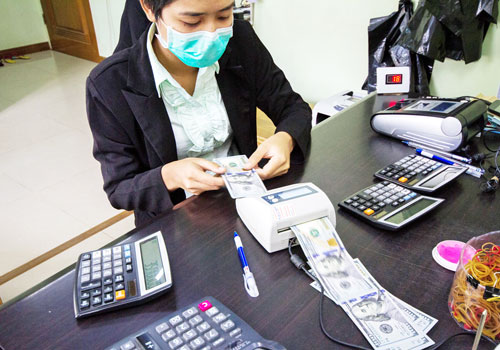A difference between the official and unofficial exchange rate remains despite the Central Bank of Myanmar has brought its reference rate close to market's
17 Jul 2015
The kyat has depreciated for most of the year against the US dollar, though the Central Bank’s official exchange rate had not kept pace with the drop in market rate used by businesses. This created a gap between the legal, official rate and the unofficial market rate.
Businesses had complained of the trouble of exchanging currencies , as it is illegal to trade more than 0.8 percent from the official rate. The Central Bank moved to address this problem on July 13, changing the official rate from K1125 to K1200 a dollar overnight, bringing it much nearer to the market rate. On July 14 it raised the official rate to K1205, and again yesterday to K1210 per dollar.
, as it is illegal to trade more than 0.8 percent from the official rate. The Central Bank moved to address this problem on July 13, changing the official rate from K1125 to K1200 a dollar overnight, bringing it much nearer to the market rate. On July 14 it raised the official rate to K1205, and again yesterday to K1210 per dollar.
Still, insiders say a gap between the official and the market rate has persisted. Yesterday the market rate was about K1230 per dollar, against K1210 for the Central Bank’s official rate – a much smaller difference than most of the year, but still enough to cause some headaches for banks and businesses.
A Central Bank official said the bank is working to converge the two rates.
“We will bring the rates closer by directly communicating the situation to people, as well as selling US dollars to importers and by trying to reduce market distortion and inflation, as much as the Central Bank can,” he said.
A tightened monetary policy through deposit auctions and treasury bill auctions will also help reduce excess liquidity, he said.
“The US dollar has been strong [against the kyat] over the short term, but hopefully it is stable in the medium term, and may depreciate in the long term when more foreign exchange flows into the country,” he said.
CB Bank managing director U Pe Myint said demand for US dollars is based on trade flows. He welcomed the recent efforts by the Central Bank, noting many banks had prices of about K1218 yesterday, within the Central Bank’s band of plus or minus 0.8pc of the official reference rate.
“This is a good sign for the official market,” he said. “Hopefully Central Bank officials will carefully adjust its reserve and supply in this situation.”
Other experts said they support the Central Bank of Myanmar’s change in course.
“We welcome the CBM’s decision [on July 13] to move the CBM reference rate in line with the broader market rates,” said International Monetary Fund (IMF) resident representative Yu Ching Wong in an e-mail. “This move should help to balance the foreign exchange market by bringing more foreign exchange back to the market and reducing demand for foreign exchange,”
by bringing more foreign exchange back to the market and reducing demand for foreign exchange,”
She added the IMF understands the Central Bank of Myanmar is also in the process of tightening monetary policy by scaling up deposit auctions. “We welcome this development, which will help reduce credit growth, lower inflation pressure, and anchor exchange rate expectations,” she said.
U Soe Thein, a banker and former deputy director general of the Ministry of Finance, said the Central Bank should work to stabilise swings in the exchange rate, adding it will need to keep its eye on volatility for the long-term.
The Central Bank is still relatively new to using monetary tools and modern market intervention techniques, as it had only adopted a managed float for the kyat three years ago. Amendments are planned to the 2012 Foreign Exchange Management Law aimed at assisting with stabilising the exchange rate.
U Soe Thein said the rising trade deficit has affected foreign reserves, while the rising budget deficit has led to inflation and lowered the value of the kyat. Government income has declined as theNATURAL GAS PRICE![]() fell, while imports of goods such as automobiles and fuel are rising.
fell, while imports of goods such as automobiles and fuel are rising.
The result is that the formal market has not been able to competitively supply US dollars to the extent that is required, he said.
“The foreign exchange supply through the Central Bank of Myanmar auction is not enough to meet the market’s requirements. It was not effective even though the rate is now driven by the market,” said U Soe Thein. He added the fundamental balance between demand and supply needs to be altered.
Foreign reserves are enough to cover about three months of imports, which is somewhat low.











